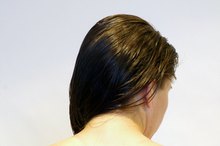Red Bumps on My Breasts
Different areas of the breast can become irritated or inflamed, leading to red bumps over the area. However, sometimes normal anatomy and skin changes can cause the same features.
It's good to understand when red bumps on the breast are worrisome and when they are not. If you have concerns about your breasts, you should consult your doctor.
Changes During and After Pregnancy
The breasts go through changes during and after pregnancy. Montgomery glands are oil-producing glands in the areola that can become larger due to hormonal changes.
**This tissue can appear as darkened bumps over the breast and is normal.
** During breastfeeding, you could be at risk for mastitis 2. Bacteria from your child's mouth or normal bacteria from your skin can infect the milk ducts. This can cause local swelling, pain, redness, bumps and fever.
In some instances, a pocket of infection, or abscess, forms. Antibiotics are often needed to resolve these infections. Breastfeeding can usually continue during treatment.
- The breasts go through changes during and after pregnancy.
- This tissue can appear as darkened bumps over the breast and is normal.
Inflammation and Infection
Boils While Breast-feeding
Learn More
Rashes and infections can appear as red bumps on the breast. Heat rashes, for example, may be caused from excess sweating and clogging of the sweat glands.
Another type of rash can be caused by irritation around the hair follicles.
Ingrown hairs or even exposure to bacteria from a hot tub could result in inflammation and possible infection. Some women, especially if they have larger breasts, may get an irritation under their breasts from sweat that collects there. This can increase the risk of yeast infections. Your doctor will let you know if antibiotics or other treatments are needed for these conditions. Generally speaking, it is helpful to keep the skin clean and dry to decrease your risk for these rashes.
- Rashes and infections can appear as red bumps on the breast.
- Generally speaking, it is helpful to keep the skin clean and dry to decrease your risk for these rashes.
Cysts, Glands and Lumps
Cysts frequently form in the breast tissue. They tend to change in size over the course of the menstrual cycle.
If cysts are close to the surface, they can stretch the skin and give a reddened appearance. Glands, too, can become enlarged if they become clogged with debris. Fox-Fordyce disease, for example, is a condition that affects sweat glands in the areola of the breast.
This results in bumps over the area that may appear red. If you feel a lump in your breast, have your doctor examine you and exclude the possibility of breast cancer.
- Cysts frequently form in the breast tissue.
Common Skin Conditions
Pimple-Like Bumps on the Breast
Learn More
Growths on the skin can develop with age, and the breast is no exception.
Blood vessels may cluster at the skin surface, giving these spots a bright red appearance. These are known as cherry angiomas.
Skin can also overgrow with spots that appear thickened and dark. These seborrheic keratoses can have a "stuck on" appearance. Neither of these skin changes is cancerous.
Eczema on the skin is also a common finding.
However, dry, scaling skin over the nipple or areola warrants further attention; it could be a sign of Paget disease, a rare type of breast cancer. As with any any skin findings, if there are changes in color or size, evaluation by your doctor is a good idea.
- Growths on the skin can develop with age, and the breast is no exception.
- Blood vessels may cluster at the skin surface, giving these spots a bright red appearance.
Related Articles
References
- American Family Physician: Common Breast Problems
- American Family Physician: Management of Mastitis in Breastfeeding Women
- American Family Physician: Intertrigo and Common Secondary Skin Infections
- Journal of Clinical Pathology: Mammary and Extramammary Paget’s Disease
- Color Atlas & Synopsis of Clinical Dermatology, 4th Edition; Thomas B. Fitzpatrick
- National Cancer Institute. Inflammatory Breast Cancer.
- National Cancer Institute. Paget’s Disease of the Breast.
- Laas E, Touboul C, Kerdraon O, Catteau-jonard S. [Inflammatory and infectious breast mastitis outside of pregnancy and lactation: Guidelines]. J Gynecol Obstet Biol Reprod (Paris). 2015;44(10):996-1016. doi:10.1016/j.jgyn.2015.09.055
- National Institute of Health. Eczema (Atopic Dermatitis).
- National Institutes of Health. Psoriasis Types.
- National Cancer Institute. Inflammatory Breast Cancer.
- National Cancer Institute. Paget’s Disease of the Breast.
- Kontoes P, Gounnaris G. Complications of Fat Transfer for Breast Augmentation. Aesthetic Plast Surg. 2017 Oct;41(5):1078-1082. doi: 10.1007/s00266-017-0911-2. Epub 2017 Jun 22.
Writer Bio
Tanya Feke is a board-certified family physician with interests in preventive medicine, lifestyle modification and women's health. Her book "Medicare Essentials" is an Amazon bestseller. She has been published in the journal "Medical Economics" and has managed her educational website Diagnosis Life (www.diagnosislife.com) since 2010.







